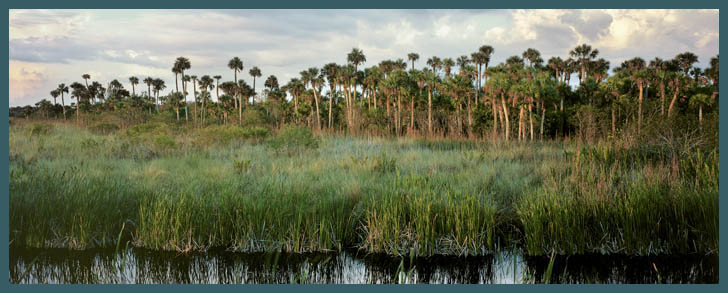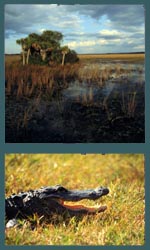|
Florida Everglades
Florida Everglades Settlement
At the end of the nineteenth century the south Florida coast was still largely wilderness, one of the last coastal regions east of the Mississippi to be settled. Only three small communities -- Chokoloskee, Cape Sable and Flamingo -- existed along the coast of what is now Everglades National Park.
Early mariners knew about Cape Sable, located west of Flamingo as it appeared on their maps. It was here in 1838 that Dr. Henry Perrine was given a grant of land. Unfortunately his plans for a settlement did not materialize due to his untimely death at the hands of Indians. Another plan for settlement was proposed by Surgeon General Thomas Lawson who explored the Cape in 1838 for the U.S. government. He built Fort Poinsett on Cape Sable. In 1856 during the Third Seminole War, Fort Cross was established at Middle Cape.
The town of Flamingo was established in 1893; its citizens had to choose a name in order to obtain a post office. According to records from the National Archives, Howell C. Low was the first postmaster. He was appointed on December 13, 1893. Cape Sable had its own post office and Jay L. Watrons was appointed postmaster on February 23, 1904.
The 1910 federal census record shows 49 people living in Flamingo and Cape Sable. Most listed their profession as farming. There were ten heads of households, with 18 children and seven servants. Five people were cane farmers and one worked in charcoal making. (Charcoal was sold in 100 pound sacks at Key West.) Jobs that other individuals held were boatmen, farmer, hauling cane, cane farming (13) and one was retired. We also know from tradition that many, if not all, fished for cash and food. Most also hunted. At the turn of the century plume hunting was a major source of cash income.
Chokoloskee, near present-day Everglades City, was first settled in the 1870s, although it had been the home of Calusa Indians for centuries in pre-Columbian times. It became the trade center for homesteaders scattered throughout the Ten Thousand Islands region.
Charles McKinney was Chokoloskee's first postmaster; he was commissioned on June 30, 1892. George Storter was commissioned as postmaster for Everglades on July 19, 1893.
The 1910 census for Everglades township, including Chokoloskee Island, listed 144 people in 29 different households. Many were farmers or farm laborers. Of those, most were probably engaged in the labor-intensive growing of sugar cane. There was also one carpenter, a mail carrier, a wash woman, a sailor, and a school teacher.
Two men made their livings as merchants, Charles "Ted" Smallwood and George Storter. The largest family, their name illegible in the records, had twelve members.
The Everglade and Chokoloskee community was just recovering from a hurricane in 1909 when it was devastated by another, the worst on record, the following year. Only the highest ground of the old Calusa shell mound remained above water. Low-lying farm fields were salted by flood tides and most cisterns were polluted, a major tragedy in an area where few springs or wells existed. Many inhabitants of the outlying islands were forced to abandon their homesteads. The most infamous incident of the times, the vigilante murder of a local man suspected of several murders, occurred a few days after the hurricane. A fictionalized account of the event is told in the book Killing Mister Watson by Peter Matthiesson.
In the early days the only way to arrive at Flamingo or Chokoloskee was by boat. Supplies were shipped from Key West, Fort Meyers or Tampa and cane syrup, fish, and produce were traded in return. Although neither town was ever to become a metropolis, they did have commerce, with some vegetables from Chokoloskee even reaching New York City.
When Royal Palm state park was created in 1916, a road was built from Florida City to Royal Palm hammock. The Ingraham Highway, as it was eventually named, was later completed to Flamingo. The name highway gave more prominence to this road than it actually deserved. Often it could only be traveled in good weather and it was always full of ruts and mud holes. Early visitors could however enjoy the scenic Everglades as they traveled this road.
Prosperity of a sort reached Everglades City in the 1920s when Barron Collier made it his headquarters for the building of the Tamiami Trail across south Florida. It served as the county seat of Collier County until 1960, when prosperity waned and county offices were moved to Naples. Neighboring Chokoloskee did not have a road until a causeway was built from the mainland in 1956.
Flamingo, still marking the end of the main park road, is now a park community with a campground, ranger station, marina and lodge. Chokoloskee, surrounded by park waters at the end of Highway 29, is still home to fishermen, with a few motels and a resort having been added for park visitors. Although the tiny cane farms and fishing shanties are gone, both areas maintain the tranquil beauty for which they are famous.
Information Provided by the National Park Service
|


